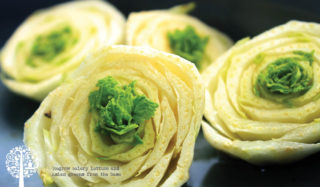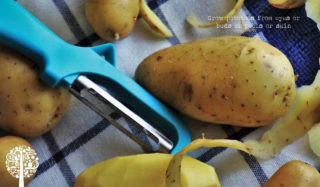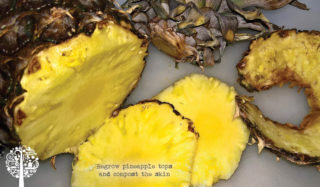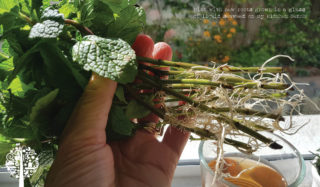Are your grocery bills getting bigger? You’re not alone. Global food prices are on the rise as producers continue to face ingredient and labor shortages, as well as increased transportation costs. And consumers are paying the price. According to the UN Food and Agricultural Organisation’s monthly Food Price Index, the cost of food jumped 33% in September 2021 compared to the same time last year. With no relief in sight, it might be time we all get our kitchen gardens growing. Anne Gibson offers some budget-friendly ways to get started.
Look no further than your kitchen to live more sustainably, save money, and grow edibles for greater food security! By closing the loop on food waste, we can achieve these goals by regrowing food from leftovers, saving seeds, propagating new plants for free, and making our nutrient-rich fertilizers.
I recently moved to a smaller block and need to maximize space indoors and out to grow food. My kitchen bench, several windowsills and rooms are the sunniest, so I’ve utilized these spaces. Your most well-lit rooms, with direct sunlight or natural light for several hours of the day, can be enough to grow some plants indoors.
Use 100% Fresh Food ‘Waste’
The easiest way to grow food is from your fridge or pantry. When we prepare meals, there are many opportunities to grow new plants from peels, seeds, stems, and leftover parts of our fruit, vegetables, and herbs. These are a few budget-friendly ways I propagate new plants, minimize food waste and recycle scraps.
Vegetables
• Leeks – If buying leeks, pick those with roots still attached so you can eat your leek and grow one too! Cut off the stem 2cm above the roots and put the base in a glass of liquid seaweed to grow new shoots. When green leaves appear from the center, transplant them deeply into a pot, mound up well, and then mulch. I’ve regrown dozens of leeks this way! Leeks also produce an abundance of seeds to grow more free plants.
• Spring onions – If you want to start growing them on your kitchen bench, buy a bunch with roots on and snip off the stems at least 5-7cm above the roots. Put in a glass of water or liquid seaweed in a sunny spot, and watch the shoots regrow overnight. You can also plant these in a pot outdoors. When they go to flower and seed, save those to resow. Never buy again!
• Garlic – I use the smaller garlic cloves in meals and sow the largest outer cloves in a container to grow my garlic. These compact plants take up minimal space and love a warm sunny spot while growing. Every clove grows one new bulb.
• Onions – If these start to go soft or a green shoot starts to form, put in a pot of compost. While an onion doesn’t regrow itself, it will certainly provide you with onion-flavored shoots similar to spring onions.
• Tomato – Too soft or ripe? Scrape seeds out and save the flesh for cooking in sauces or soups. Soak seeds in water until they ferment (2-3 days). Fermenting naturally removes the germination-inhibiting enzymes around the seeds. Strain off the scum from the water, rinse seeds well, and dry on paper towel strips ready to store or sow. Compost leftovers and use the fermented water as a liquid plant fertilizer.
• Regrow Greens – After harvesting the leaves, I replant the base of celery, lettuce, and Asian greens in moist potting mix, watered with liquid seaweed. New leaves shoot after roots grow from the bottom. This simple planting technique extends the harvest.

• Potatoes – The ‘eyes’ or buds on the skin develop new shoots and roots. My garden is full of potato plants that sprouted up from peelings with buds that I just buried in the soil to compost! Self-sown spuds don’t get easier than that. Leave potatoes in a well-lit spot until they start to shoot. Then bury in a deep pot, cover with compost as they grow, and enjoy the harvest in a couple of months.

• Sweet Potatoes – Similarly, the quickest way to encourage new shoots is to bury a healthy organic sweet potato in a large deep container. Keep moist in a warm sunny spot. Once you see the green shoots on young stems (slips), pick the tender leaves and eat as a vegetable (stir-fries, soups, or as a spinach substitute). Or be patient while the tubers grow.
• Pumpkin – I fully utilize its potential! Instead of scraping the seeds out and tossing, eat or sow them. Raise the seed indoors, transplant seedlings, or enjoy these high-protein seeds as a nutritious, tasty snack. Rinse and dry on an oven tray. Lightly season with your favorite flavorings like chili or garlic powder, and lightly roast. Let cool and store in an airtight jar. Peel the pumpkin skin into bite-sized pieces and lay on an oven tray. Season with salt, pepper, and a little oil. Bake for delicious healthy vegetable ‘chips.’ Add pulp to soups or curries and compost any leftovers. Zero waste!
Fruit
• Citrus – I’ve grown many fruit trees from seeds, including limes, lemons, pomelo, and mandarins. Select the plumpest seeds from ripe fruit and sow immediately into moist seed raising mix. Seeds must be fresh, and they germinate easily in warm weather. Transplant your seedling into a pot. With a little patience, you can grow your own citrus tree.
• Passionfruit – The easiest way to regrow passion fruit is to cut open a ripe fruit. Leave a few seeds in half the skin and fill with moist compost. Plant into a pot of compost, water well, and you’ll soon have seedlings. These have always been the best fruit in my garden and vines last at least five years, so you get long-term value and kilos of fruit after 12 months. Freeze the pulp in ice cubes when out of season. The peels can be used medicinally by drying and grinding into a powder. Studies have shown the peels have anti-inflammatory agents that may help reduce pain associated with arthritis and relieve asthma. Or, recycle as a compost ingredient.
• Pineapple – This has to be one of the easiest fruits to grow. Twist the top off of ripe pineapple and sit the base in a glass of water on a sunny windowsill or kitchen bench, so it stays in contact with moisture. You’ll soon see roots growing. Transplant to a pot or the garden in a sunny position. Plants fruit in around 18-24 months.

Propagating Herbs
Rosemary, thyme, mint, and basil add flavor and digestive enzymes to meals and are easy to propagate by rooting cuttings in water. Strip off the lower leaves (dry and use in cooking). Snip the base of the stem at an angle and add to water with liquid seaweed. The growth hormones encourage faster root development from leaf nodes underwater. I have several jars on my kitchen bench that photosynthesize in the direct morning sunlight and grow the rest of the day in natural indoor light. I refresh the water regularly until roots have formed, then transplant to pots for year-round herbs.


Raiding Seeds from the Pantry
• Chia – This high-protein food source is used in many ways for food, but you can also grow your own plants by merely adding water to a few seeds and allowing them to rehydrate. Add the gel to seed raising mix and cover. You’ll soon have baby plants to pot up.
• Sunflower – These seeds germinate in warm temperatures and can be grown as microgreens on your kitchen bench, ready to eat in as little as a week. Sow on seed-raising mix. Snip the stem off above the growing media when two leaves appear and enjoy these protein-rich crunchy sprouts in salads.
• Coriander – These dried seeds are used as a spice from the pantry, but you can also sow them to grow your own herb plants. Pre-soak in water and sow in cool weather.
Recycling Nutrients as Fertiliser
Crushed powdered eggshells, coffee grounds, tea leaves, tea bags, cooking water, UFO’s (Unidentified Food Objects) in your fridge crisper, torn moistened egg cartons or paper bags, and pet hair can all be composted. Add to a lidded bucket with holes in the base buried in the garden and worms will turn this organic matter into nutrient-rich free plant food. By fully utilizing our food in the kitchen, we can find more creative ways to grow edibles, save money, and minimize household waste.